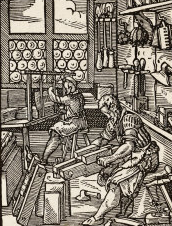Les miroirs de Virginia Woolf
Keywords:
Modernisme, Woolf, VirginiaAbstract
Des miroirs sont suspendus partout dans la fiction de Virginia Woolf, entre révélation, trahison et ekphrasis, redoublant le monde fictionnel dans leur reflet déformant, générant des images inversées qu'ils encadrent comme des tableaux. Qu'il s'agisse d'un instrument pour sauver les apparences ou qu'il provoque une confrontation brutale avec l'image publique dans laquelle les personnages sont enfermés, le miroir est la scène sur laquelle se joue le théâtre social, et l'image spéculaire est autant lieu de reconnaissance de soi que d'identification avec l'autre. Lorsque personne d'autre que le lecteur ne regarde, son reflet évoque le “réel” qui reste hors-cadre et échappe à la sphère de perception. Les miroirs de Virginia Woolf ouvrent un espace de réflexion sur la possibilité de la représentation et offrent un espace textuel meta-réflexif.
Avoiding looking-glasses in Virginia Woolf’s fiction is no easy task since they loom everywhere, oscillating between revelation, betrayal and ekphrasis, duplicating the fictional world in their distorted reflections, generating reversed images and framing them like paintings. Whether as an instrument used to control and keep up appearances or as the occasion for a brutal confrontation with the public image one is locked up in, the surface of the mirror is the theatre of the social I as much as the social eye – the specular image is the locus of both recognition of the self and identification with the other. When no one is looking into the mirror but the reader, its reflection evokes the “real” that remains outside the narrative frame – and outside the frame of human perception. Virginia Woolf’s looking-glasses open up a space for further reflection on the possibility of representation, allowing the text to reflect on itself.
Published
Issue
Section
License
- Work submitted for publication must be original, previously unpublished, and not under consideration for publication elsewhere. If previously published figures, tables, or parts of text are to be included, the copyright-holder's permission must have been obtained prior to submission.
- Authors of accepted manuscripts will assign to L'Atelier the right to electronically distribute their article, or publish it in any form (Internet, CD ROM, printed copy) but authors will retain copyright and, after the article has appeared in L'Atelier, authors may republish their text (in print and/or electronic form) as long as they clearly acknowledge L'Atelier as the original publisher.


